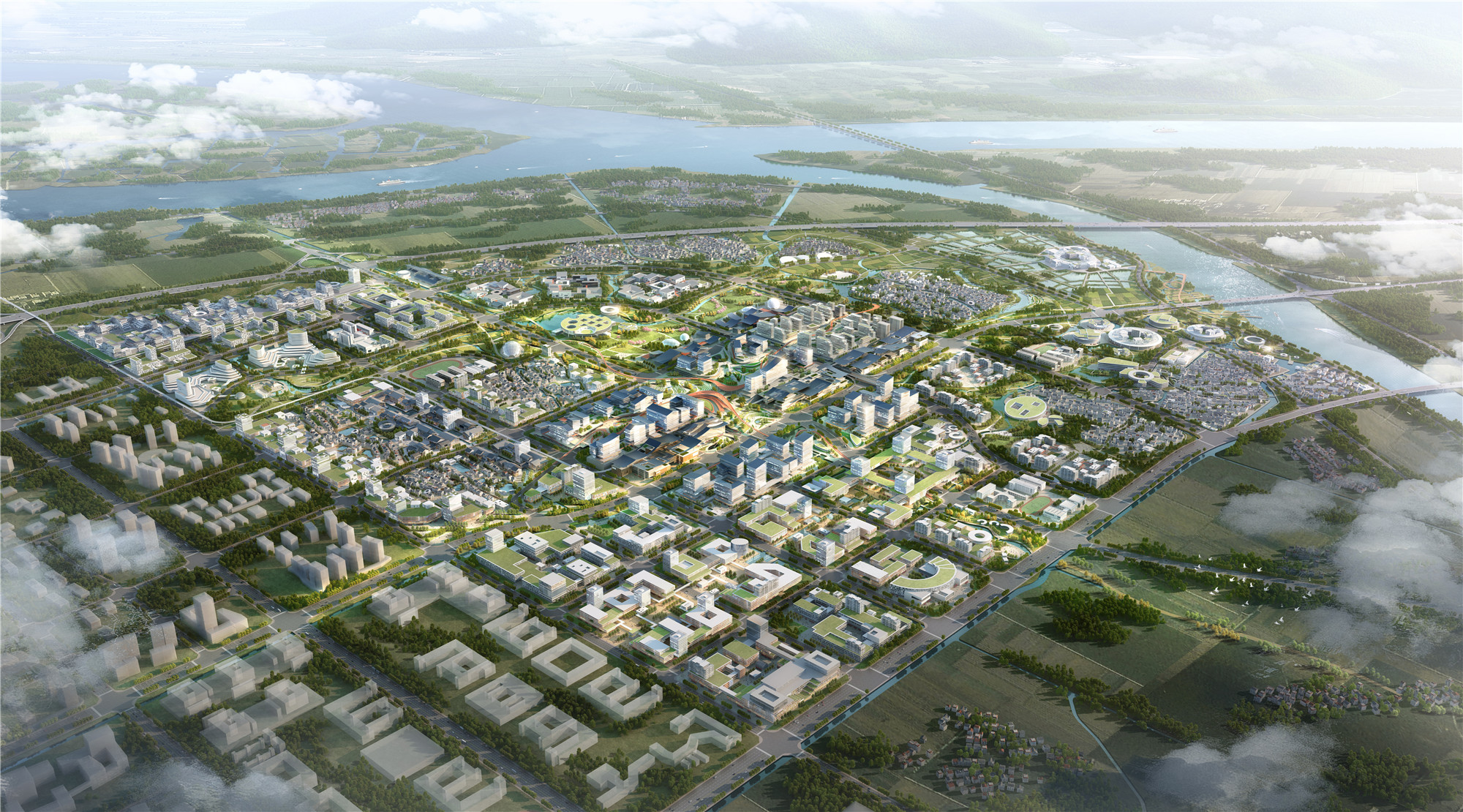
联合体成员 中国城市规划设计研究院、Aedas、哈尔滨工业大学建筑设计研究院
项目地点 浙江杭州
方案状态 中标方案
核心区建筑面积 744,700平方米
作为长三角参与区域竞合的中心城市,轨道上的杭州正力图基于创新生态雨林模式,打造综合性国家科学中心。由中规院、Aedas、HITAD联合体打造的杭州市轨道交通TOD综合开发示范项目城市设计(地铁双浦车辆段)方案,正是引领其南部新极核发展的关键。

地块现状与难点
项目位于杭州现有中心城区南部边缘,地铁6号线与33号线在此交汇,周边汇聚了众创新平台,TOD基础与创新发展潜力兼具。同时场地南临北支江、富春江,东望三江汇公园,西邻铜鉴湖、灵山风景区,绝佳的自然环境也造就了极具临安风情的城野客厅。


项目具有得天独厚的条件与环境,但也存在着巨大挑战。如何在充分激活周边创新要素的基础上,依托山水底色,在增强综合配套提升片区活力中,构建出独具杭州特色且“工作—生活”一体化的TOD枢纽,避免轨道交通末端易形成的“卧城模式”,是摆在设计面前的难题。
融合城野,创造活力
团队提出了四大设计策略——创源链接、无界城野、多维坊巷、无形智网,以期在可云游山水、洄游坊巷、纵游城野的公顷尺度中构建立体城市场景。
设计结合地形和现状塘浦体系,以水为脉串联基地,塑造具有双浦特色的多形态水链生态系统,并以此为基础构建绿色生态走廊,以蓝绿走廊与功能走廊贯通北城南野,形成城境与野趣不同风貌。

同时,绿色网络与城市功能彼此交织,设计结合功能业态分布构建“西研、中创、东园、南野”的整体布局,并基于TOD站点为核心打造了双浦十字结构。整体规划结合产业功能平台空间模式,衔接北部及西部创新资源,构建从前端创新到中端智造,再到后端贸易的全链条创新同盟。以“双浦硅谷”联动周边创新资源,塑造未来创新引擎,弥合杭州创新体系。



团队深入探索杭州传统空间组织及人文底蕴,通过对杭州“院、园、街、坊”等文化空间原型进行提炼与现代化演绎,构建出七类不同尺度的坊巷组团模式,以最具杭州特色的多维坊巷,满足不同产业功能和未来人群需求。


同时设计以大尺度的街巷形式连接各功能组团,以“山、野、城、水”四大要素,形成自然环境与城市空间的无缝连接,并识别村落价值,实现城村共存。设计依托整体空间结构铺设智能化设施及智慧网络,并运用到城市建设之中,形成东西向的“智慧空间实验轴线”和南北向的“数智交通创新轴”,创造新型数字技术应用场所。


Aedas团队主要设计人梁志华表示:“在城市之中,综合枢纽不应是一个独立新城,而应融入区域交通网络和创新网络,成为其中密不可分的一部分。我们希望基于双浦的自然基底,从山水人文角度出发,打造一座看不见的车辆段,以功能完整、空间多维连接渗透的TOD,塑造双浦未来新城。”
▲ 视频介绍 ©中规院+Aedas+HITAD
看不见的车辆段
设计运用大地景观手法,将突兀的城市巨构隐逸于风景之中。从景观绿色区域到商业活力界面,设计以层层推进的形式,通过多维渗透的景观层次模糊各个层级的边界,化解了车行道附近不宜人的尺度,从视觉上弥合高差。多元功能溶解于自然之中,建筑与自然耦合间,呈现出多元交互场景,让车辆段隐藏到城市的环境空间里,形成“看不见的车辆段”。

为呼应周边自然环境,设计抽象凝练河浦形态,将双浦诠释为数创浦和书香浦两条景观河浦,并以十字轴线的布局贯穿车辆段上盖区域。河谷中设有空中云廊步道,底层架空,形成自然通风,让绿色渗透其中,与内部景观融为一体。


设计围绕视线通透的中央河谷植入了丰富的城市功能,并跨越车辆段串联起城市空间。其中核心区竖向分为6层,从负20米的地铁站台层一直到15米的上盖开发层,充分利用好地上地下空间,为开发预留充足的弹性。


站城无界一体化
团队充分发挥城市地铁的优势条件,以轨站引导城市生活,拓展街区级交通系统。设计在地面设置枢纽综合大厅,开阔的中庭空间可将阳光引入地下,在营造独特的到达感的同时,以自然光引导换乘路径,实现与地面公交总站和预留中运量轨道交通的无缝换乘。
同时,枢纽大厅也串联起盖上盖下的城市空间,多元的城市功能渗透进多维空间,通过竖向层次划分,植入换乘体系,丰富枢纽功能。位于地下一层的商业连廊串联各功能业态,实现全天候无惧风雨的连接,打造一个以人为本的无界枢纽。


整体业态基于核心区现状划分为四个部分:北部为数字创新坊,以数创、商住以及商业开发为主;集会展、文化、休闲等功能于一体的核心景观中轴作为间隔,划分其与南侧的中部文创复合坊;南部为河西新区的主要生活消费区——未来生活坊,以商业街结合住宅开发为主。


延续杭韵文脉
设计从飘舞的水袖形态中汲取灵感,结合传统江南飘逸舒展的建筑语言,重新演绎有着千年历史的杭州坊巷,将以居住为主的传统坊巷,变为多功能复合的单元,通过明巷直街确保交通方便可达,并以窄弄暗巷划分公共和私密空间,基于传统打造出迎合数字时代需求的新坊巷。
同时,设计重新转译传统江南建筑屋顶语言,结合现代的光伏屋面,形成衔接自然顺应文脉的城市天际线,既满足江南画意,又符合未来低碳城市需求。


总而言之,设计希望在城野交融中,以TOD综合开发为切入点,建构未来双浦的秩序和特征,并以原研创新为锚点引导创新培育,通过创新云廊串联融合山水乡田的未来综合体,营造双浦极境枢城。

附文:
项目英文介绍
The Hangzhou Shuangpu Depot is located on the southern edge of Hangzhou’s downtown area where two future MTR lines will converge. The site is immediately adjacent to the Fujiang River and enjoys superb natural and cultural resources from the surrounding mountains, wetlands and existing villages. Neighbored by illustrious research institutions, the project is set to be a leading force of Hangzhou’s ambition to become a national science center and innovative future city.
Master Planning & Urban Design
The design thoroughly explores the site’s topography and cultural heritage to construct a comprehensive development where nature and urbanity merge. By recontextualising Hangzhou’s traditional spatial organizations, functional clusters of different scales with prominent Hangzhou characteristics are generated on the land of 7.59 ha. These functional clusters, including research and innovation platforms, residential communities, art and cultural zones, and eco-cultural tourism, are set to create an ultimate urban habitat for future talents, tourists as well as local community.
Adapted from the existing terrain, the functional clusters are embedded in an ecological system with local features, composed of various ecological spaces such as water lanes, ponds, lake gardens, water blocks and water hills. Drawing from both natural and urban city elements, the design promotes the harmonious coexistence between the city and the village.
The plan is to supplement public service facilities like medical and educational institutions, then based on the existing village space configurations with partial renovations, new functions such as cultural and sports facilities, art workshops, and commercial retail are put in place. Through strategic planning and establishing a centralized intelligent networks, smart facilities and amenities are concentrated in a spatially logic manner, producing a hub for new digital technology applications.
Core Area - Integrated Design of Shuangpu Depot
The design incorporates an important central axis along the core area of Shuangpu depot to link the functional clusters with a multi-layered green pedestrian network. Surrounding the central valley, rich urban functions are implanted.
The Integrated TOD Hub
The station core area is vertically divided into 6 layers, providing seamless connection from the subway platform to the transition hall and developments on top – from carpark, commercial retail, to public facilities and offices. A cloud corridor is established for ease of access and to encourage users to meander.
To expand and optimise the transportation system, a comprehensive hub is created between subway and urban space which allows seamless connection between subway, bus service, and rail transit. An open atrium space is installed to introduce sunlight and produce a unique sense of arrival.
The function on the depot is mainly smart industry office, and the residential units are arranged in the south. The landing area on one side of the hub is equipped with commercial, cultural and creative functions, which is closely connected with the subway. The multi-functional format meets the diversified needs of work, life and leisure.
The design reinterprets Hangzhou lanes and organises them according to modern architectural logic. Pitched roof is a common element widely used in existing traditional villages. In the Shuangpu depot, the double slope roof is fashioned into the single slope roof aligned with contemporary architecture.
“The TOD comprehensive development lends itself to the ideal future Shuangpu: by integrating urban and rural areas and promoting innovation, this sweeping Shuangpu hub city will forge new and exciting paths." said Aedas Executive Director Leon Liang.
出入线区各层平面图 ▽




完整项目信息
项目:杭州市轨道交通TOD综合开发示范项目城市设计国际方案公开征集(地铁双浦车辆段)
位置:中国杭州
总体规划、城市设计及核心区建筑概念设计:中国城市规划设计研究院、Aedas、哈尔滨工业大学建筑设计研究院联合体
业主:杭州市规划和自然资源局、杭州市地铁集团有限责任公司
总体规划用地面积:7.59平方千米
核心区建筑面积:744,700平方米
竣工年份:进行中
Aedas主要设计人:梁志华(Leon Liang)
版权声明:本文由Aedas授权发布。欢迎转发,禁止以有方编辑版本转载。
投稿邮箱:media@archiposition.com
上一篇:雁荡鱼跃:“上海之鱼”三、四号桥 / 高目
下一篇:乐清市荆山公学 | 浙江大学建筑设计研究院有限公司